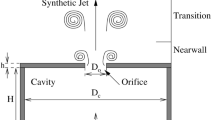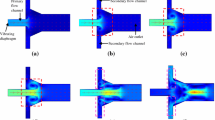Abstract
Flow separation and secondary flow in the S-duct of an aircraft engine cause severe pressure loss and airflow distortion at the outlet, lowering engine performance. Herein, a serial two-electrode plasma synthetic jet (PSJ) actuator array is used to actively control the flow field in the duct and improve its characteristics. The results show that the PSJ significantly increases the wall pressure recovery coefficient, suppresses flow separation, and improves the outlet pressure distortion. The primary and secondary orders of the influencing factors are as follows: control position>jet momentum coefficient>excitation frequency>jet configuration. The best jet control position is near the separation location, and the best jet configuration is the ‘Λ’ configuration. The higher the jet momentum coefficient and excitation frequency, the better the flow control. The wall pressure coefficient increases by up to 127.8%, and the outlet steady pressure distortion index decreases by 9.15%. The control mechanism is the direct energy injection into the flow boundary layer through a high-speed jet and the indirect control effect of the induced streamwise vortex. On the one hand, the PSJ suppresses flow separation by improving the ability of the boundary layer to resist the inverse pressure gradient. On the other hand, it reduces pressure distortion by decreasing the intensity of the secondary flow and weakening the backflow. This study thus provides a new technology for the active control of the flow-field characteristics in an S-duct and has significance for guiding the application of synthetic jet technology in S-ducts.
摘要
目的
S形进气道内的流动分离和二次流造成进气道出口压力损失和气流畸变较为严重, 严重影响发动机的工作性能。为改善其流场特性, 本文采用串联式等离子体合成射流主动控制进气道内的流场, 抑制进气道内流动分离和出口压力畸变, 提高进气道气动性能。
创新点
1. 系统探究等离子体合成射流控制位置、布局形式、动量系数和激励频率对控制效果的作用规律, 并采用正交实验法确定上述参数的主次和最优组合。2. 从流向和出口截面流场及压力分布出发, 厘清等离子体合成射流主动控制S型进气道流动的机理。
方法
1. 在低速风洞试验中(图2), 利用压力扫描阀采集进气道壁面静压分布和出口总压分布, 并通过粒子图像测速(PIV)技术测量进气道壁面沿程和出口流场(图5)。2. 在壁面布置等离子体合成射流阵列对进气道内的流动分离进行主动控制, 改变等离子体合成射流相关参数(图7和9), 探究其作用规律, 并利用正交实验法确定各参数的影响主次。3. 通过对比分析沿程、出口的流场和压力分布(图13), 探究等离子体合成射流控制流动分离的机理(图16)。
结论
1. 等离子体合成射流能够显著提高静压恢复系数, 抑制流动分离并改善出口压力畸变; 射流控制位置在分离点附近最佳, 而‘Λ’型布局形式是最优的。2. 本实验中, 壁面静压系数提高最大可达127.8%, 而出口稳态畸变指数降低了9.15%。3. 控制机理是高速射流的直接能量注入及其产生的流向涡间接控制效应; 一方面, 可提高边界层抵抗逆压梯度的能力, 抑制流动分离; 另一方面, 可有效降低二次流的强度, 减弱出口截面回流, 降低压力畸变。
Similar content being viewed by others
References
Amitay M, Pitt D, Glezer A, 2002. Separation control in duct flows. Journal of Aircraft, 39(4):616–620. https://doi.org/10.2514/2.2973
Anderson BH, Gibb J, 1992. Application of computational fluid dynamics to the study of vortex flow control for the management of inlet distortion. Proceedings of the 28th Joint Propulsion Conference and Exhibit. https://doi.org/10.2514/6.1992-3177
Ball WH, 1985. Tests of wall suction and blowing in highly offset diffusers. Journal of Aircraft, 22(3): 161–167. https://doi.org/10.2514/3.45102
Chedevergne F, Leon O, Bodoc V, et al., 2015. Experimental and numerical response of a high-Reynolds-number M= 0.6 jet to a plasma synthetic jet actuator. International Journal of Heat and Fluid Flow, 56:1–15. https://doi.org/10.1016/j.ijheatfluidflow.2015.06.008
Chen ZJ, Wang JJ, 2012. Numerical investigation on synthetic jet flow control inside an S-inlet duct. Science China Technological Sciences, 55(9):2578–2584. https://doi.org/10.1007/s11431-012-4970-y
Cybyk BZ, Simon DH, Land III HB, et al., 2006. Experimental characterization of a supersonic flow control actuator. Proceedings of the 44th AIAA Aerospace Sciences Meeting and Exhibit. https://doi.org/10.2514/6.2006-478
Debiasi M, Herberg MR, Yan Z, et al., 2008. Control of flow separation in S-ducts via flow injection and suction. Proceedings of the 46th AIAA Aerospace Sciences Meeting and Exhibit. https://doi.org/10.2514/6.2008-74
Delot AL, Garnier E, Pagan D, 2011. Flow control in a highoffset subsonic air intake. Proceedings of the 47thAIAA/ASME/SAE/ASEE Joint Propulsion Conference & Exhibit. https://doi.org/10.2514/6.2011-5569
Dong XR, Chen YH, Dong G, et al., 2016. Research on control of hypersonic shock wave/boundary layer interactions by double micro-ramps. Acta Armamentarii, 37(9):1624–1632 (in Chinese). https://doi.org/10.3969/j.issn.1000-1093.2016.09.011
Emerick T, Ali MY, Foster C, et al., 2014. SparkJet characterizations in quiescent and supersonic flowfields. Experiments in Fluids, 55(12):1858. https://doi.org/10.1007/s00348-014-1858-6
Garnier E, Leplat M, Monnier JC, et al., 2012. Flow control by pulsed jet in a highly bended S-duct. Proceedings of the 6th AIAA Flow Control Conference. https://doi.org/10.2514/6.2012-3250
Gissen AN, Vukasinovic B, McMillan ML, et al., 2014. Distortion management in a boundary layer ingestion inlet diffuser using hybrid flow control. Journal of Propulsion and Power, 30(3):834–844. https://doi.org/10.2514/LB34981
Grossman KR, Cybyk BZ, VanWie DM, 2003. Sparkjet actuators for flow control. Proceedings of the 41st Aerospace Sciences Meeting and Exhibit. https://doi.org/10.2514/6.2003-57
Gu RY, Shan Y, Zhang JZ, et al., 2018. Numerical study on transport aircraft after-body flow separation control by spark jet. Journal of Aerospace Power, 33(8):1855–1863 (in Chinese). https://doi.org/10.13224/j.cnki.jasp.2018.08.008
Harrison NA, Anderson J, Fleming JL, et al., 2013. Active flow control of a boundary layer-ingesting serpentine inlet diffuser. Journal of Aircraft, 50(1):262–271. https://doi.org/10.2514/LC031818
He P, Dong JZ, 2015. Effect of slot orientation on synthetic jet-based separation control in a serpentine inlet. Journal of Aerospace Power, 30(2):306–314 (in Chinese). https://doi.org/10.13224/jxnki.jasp.2015.02.007
Huang EL, Kang JX, Wang P, et al., 2013. An investigation of micro-jet control in a compact S-shaped intake. Gas Turbine Technology, 26(3):21–27 (in Chinese). https://doi.org/10.3969/j.issn.1009-2889.2013.03.004
Jenkins LN, Gorton SA, Anders SG, 2002. Flow control device evaluation for an internal flow with an adverse pressure gradient. Proceedings of the 40th AIAA Aerospace Sciences Meeting & Exhibit. https://doi.org/10.2514/6.2002-266
Jia YH, Liang H, Zong HH, et al., 2022. Flow separation control in S-shaped ∼inlet with a nanosecond pulsed surface dielectric barrier discharge plasma actuator. Journal of Physics D: Applied Physics, 55(5):055201. https://doi.org/10.1088/1361-6463/ac2f15
Jiang H, Liu J, Luo SC, et al., 2020. Hypersonic flow control of shock wave/turbulent boundary layer interactions using magnetohydrodynamic plasma actuators. Journal of Zhejiang University-SCIENCE A (Applied Physics & Engineering), 21(9):745–760. https://doi.org/10.1631/jzus.A2000025
Li BB, ChenG KM, Gu YS, 2012. Separation flow control of beveled synthetic jet actuator in S-shaped inlet. Journal of Experiments in Fluid Mechanics, 26(2):34–37 (in Chinese). https://doi.org/10.3969/j.issn.1672-9897.2012.02.007
Lin Q, Guo RW, 1989. Vortex control investigation of swirl in S-shaped diffuser. Acta Aeronautica et Astronautica Sinica, 10(1):35–40 (in Chinese).
Liu RB, Niu ZG, Wang MM, et al., 2015. Aerodynamic control of NACA 0021 airfoil model with spark discharge plasma synthetic jets. Science China Technological Sciences, 58(11):1949–1955. https://doi.org/10.1007/s11431-015-5881-5
Liu RB, Lin RX, Lian GC, et al., 2021. Multichannel plasma synthetic jet actuator driven by Marx high-voltage generator. AIAA Journal, 59(9):3417–3430. https://doi.org/10.2514/LJ060222
Mathis R, Duke D, Kitsios V, et al., 2008. Use of zero-netmass-flow for separation control in diffusing S-duct. Experimental Thermal and Fluid Science, 33(1):169–172. https://doi.org/10.1016/j.expthermflusci.2008.07.005
Meng T, Dong JZ, Wu XY, 2016. Active flow control with fluidic in S-shaped inlet. Science Technology and Engineering, 16(32):319–324 (in Chinese). https://doi.org/10.3969/j.issn.1671-1815.2016.32.055
Ng YT, Luo SC, Lim TT, et al., 2011. Three techniques to control flow separation in an S-shaped duct. AIAA Journal, 49(9):1825–1832. https://doi.org/10.2514/LJ050135
Ning L, Tan HJ, Sun S, 2017. Effects of boundary layer ingestion on flow characteristics of an S-shaped inlet. Journal of Propulsion Technology, 38(2):266–274 (in Chinese). https://doi.org/10.13675/jxnki.tjjs.2017.02.004
Pan JJ, 2014. Research on the Flow Field Characteristics and Flow Control of S-shaped Inlet. MS Thesis, Nanjing University of Aeronautics and Astronautics, Nanjing, China (in Chinese).
Sahni O, Olles J, Jansen KE, 2009. Simulation of flow control in a serpentine duct. Proceedings of the 47th AIAA Aerospace Sciences Meeting Including the New Horizons Forum and Aerospace Exposition. https://doi.org/10.2514/6.2009-1326
Sary G, Dufour G, Rogier F, et al., 2014. Modeling and parametric study of a plasma synthetic jet for flow control. AIAA Journal, 52(8):1591–1603. https://doi.org/10.2514/1.J052521
Schlichting H, Gersten K, 2017. Boundary-Layer Theory. Springer, Berlin, Germany. https://doi.org/10.1007/978-3-662-52919-5
Shin JY, Kim HJ, Kim KH, 2021. Development of one-dimensional analytical model for a SparkJet actuator. AIAA Journal, 59(3):1055–1074. https://doi.org/10.2514/1.J059619
Sun J, Niu ZG, Liu RB, et al., 2019. The wind tunnel test of the active flow control on the flying wing model based on the plasma synthetic jet. Journal of Experiments in Fluid Mechanics, 33(4):81–88 (in Chinese). https://doi.org/10.11729/syltlx20190041
Tang MX, Wu Y, Wang HY, et al., 2018. Characterization of transverse plasma jet and its effects on ramp induced separation. Experimental Thermal and Fluid Science, 99:584–594. https://doi.org/10.1016/j.expthermflusci.2018.05.023
Vaccaro JC, Elimelech Y, Chen Y, et al., 2015. Experimental and numerical investigation on steady blowing flow control within a compact inlet duct. International Journal of Heat and Fluid Flow, 54:143–152. https://doi.org/10.1016/j.ijheatfluidflow.2015.05.011
Wang HY, Li J, Jin D, et al., 2018. High-frequency counter-flow plasma synthetic jet actuator and its application in suppression of supersonic flow separation. Acta Astronautica, 142:45–56. https://doi.org/10.1016/j.actaastro.2017.10.023
Wang P, Shen CB, 2019. Characteristics of mixing enhancement achieved using a pulsed plasma synthetic jet in a supersonic flow. Journal of Zhejiang University-SCIENCE A (Applied Physics & Engineering), 20(9):701–713. https://doi.org/10.1631/jzus.A1900130
Weng PF, Guo RW, 1992. New method of swirl control in a diffusing S-duct. AIAA Journal, 30(7):1918–1919. https://doi.org/10.2514/3.11156
Wojewodka MM, White C, Shahpar S, et al., 2018. A review of flow control techniques and optimisation in S-shaped ducts. International Journal of Heat and Fluid Flow, 74: 223–235. https://doi.org/10.1016/j.ijheatfluidflow.2018.06.016
Zhou Y, Xia ZX, Luo ZB, et al., 2018. Experimental characteristics of a two-electrode plasma synthetic jet actuator array in serial. Chinese Journal of Aeronautics, 31(12): 2234–2247. https://doi.org/10.1016/j.cja.2018.08.023
Zhou Y, Xia ZX, Luo ZB, et al., 2019. Characterization of three-electrode SparkJet actuator for hypersonic flow control. AIAA Journal, 57(2):879–885. https://doi.org/10.2514/1.J057465
Zhou Y, Luo ZB, Wang L, et al., 2022. Plasma synthetic jet actuator for flow control: review. Acta Aeronauticaet Astronautica Sinica, 43(3):025027 (in Chinese). https://doi.org/10.7527/S1000-6893.2020.25027
Zong HH, Kotsonis M, 2017a. Interaction between plasma synthetic jet and subsonic turbulent boundary layer. Physics of Fluids, 29(4):045104. https://doi.org/10.1063/1.4979527
Zong HH, Kotsonis M, 2017b. Realisation of plasma synthetic jet array with a novel sequential discharge. Sensors and Actuators A: Physical, 266:314–317. https://doi.org/10.1016/j.sna.2017.09.027
Zong HH, Kotsonis M, 2018. Formation, evolution and scaling of plasma synthetic jets. Journal of Fluid Mechanics, 837:147–181. https://doi.org/10.1017/jfm.2017.855
Zong HH, Chiatto M, Kotsonis M, et al., 2018. Plasma synthetic jet actuators for active flow control. Actuators, 7(4):77. https://doi.org/10.3390/act7040077
Acknowledgments
We would like to thank Associate Professor Jian-feng ZHU and PhD candidate Ting ZHAO of Professor Yan-cheng YOU’s research group, Xiamen University for their support in conducting the pressure measurements.
This work is supported by the Fundamental Research Funds for the Central Universities of China (No. 20720210050); the National Natural Science Foundation of China (No. 51707169); the Natural Science Foundation of Fujian Province, China (No. 2019J01042); the Aeronautical Power Fund Project, China (No. 6141B09050390); the Project on the Integration of Industry, Education and Research of Aero Engine Corporation of China (No. HFZL2018CXY009); the Xiamen University Training Program of Innovation and Entrepreneurship for Undergraduates (No. 202110384082).
Author information
Authors and Affiliations
Contributions
Xiao-yin MEI, Ru-bing LIU, Zhe-zhe SU, and Qi LIN designed the research. Xiao-yin MEI, Ru-bing LIU, Yu-wen LU, and Sheng-hui XUE processed the corresponding data. Ru-bing LIU and Xiao-yin MEI wrote the first draft of the manuscript. Sheng-hui XUE helped to organize the manuscript. Ru-bing LIU revised and edited the final version.
Corresponding authors
Additional information
Conflict of interest
Ru-bing LIU, Xiao-yin MEI, Sheng-hui XUE, Yu-wen LU, Zhe-zhe SU, and Qi LIN declare that they have no conflict of interest.
Electronic supplementary materials
Characteristics of PSJ actuator and other supplementary tables and figures.
Electronic Supplementary Materials
Rights and permissions
About this article
Cite this article
Liu, Rb., Mei, Xy., Xue, Sh. et al. Active flow control of S-duct by plasma synthetic jet. J. Zhejiang Univ. Sci. A 23, 652–668 (2022). https://doi.org/10.1631/jzus.A2100618
Received:
Accepted:
Published:
Issue Date:
DOI: https://doi.org/10.1631/jzus.A2100618




